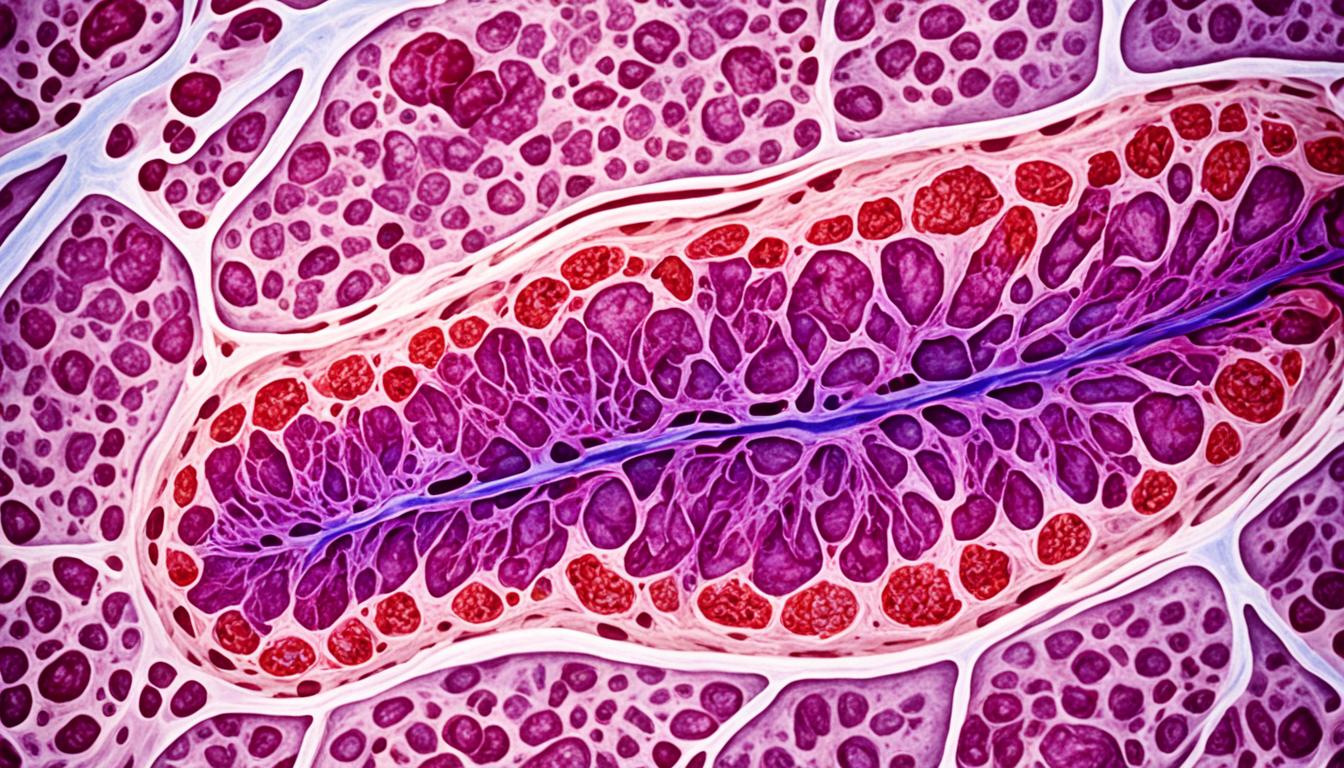Castleman disease is a rare disorder affecting the lymph nodes. It has two types: unicentric Castleman disease (UCD) and multicentric Castleman disease (MCD). This disease involves abnormal cell growth in the lymph nodes and can happen to anyone.
The exact reason for Castleman disease is not fully understood. It may be linked to problems with the immune system and viral infections. For example, the human herpesvirus-8 (HHV-8) might play a role. This disease affects the immune system, causing too much lymphatic tissue to grow.
The symptoms of Castleman disease change with the type. UCD can sometimes show no symptoms. MCD, however, often causes enlarged lymph nodes, fever, night sweats, tiredness, and weight loss. These signs are not unique to Castleman disease, making it hard to diagnose.
Doctors might do a lymph node biopsy to check for Castleman disease. Imaging tests like PET-CT scans and X-rays help see the lymph nodes better. Blood tests and tests for HHV-8 also confirm the disease’s presence.
The treatment for Castleman disease varies by type and how severe it is. For UCD, removing the affected lymph nodes through surgery might be enough for a cure. Other treatments could include taking medicines like siltuximab or rituximab. With MCD, managing symptoms and controlling the disease are the focus.
Researchers are studying stem cell therapy as a possible treatment for Castleman disease. This therapy aims to implant healthy stem cells to fix the immune system. Although still under research, stem cell therapy offers hope for new treatment paths.
Key Takeaways:
- Castleman disease is a rare lymphoproliferative disorder that affects the lymph nodes.
- It can be classified into two subtypes: unicentric Castleman disease (UCD) and multicentric Castleman disease (MCD).
- The exact cause of Castleman disease is unknown, but it is believed to involve impaired immunoregulation and viral infections.
- Symptoms of Castleman disease can include enlarged lymph nodes, fever, night sweats, fatigue, and weight loss.
- Diagnosis involves testing lymph nodes, imaging scans, and blood work.
- Treatment options include surgery, targeted therapy, and managing symptoms.
- Stem cell therapy is being researched as a potential treatment option for Castleman disease.
Types and Symptoms of Castleman Disease
Castleman disease is a rare condition that affects the lymph nodes. It has two main types: unicentric Castleman disease (UCD) and multicentric Castleman disease (MCD).
Unicentric Castleman disease (UCD) shows up as a single big lymph node or many big ones in one spot.
Multicentric Castleman disease (MCD) causes swollen lymph nodes all over the body. It comes in two forms: HHV-8-positive and HHV-8-negative.
In UCD, many don’t have any symptoms. But MCD can bring on fever, night sweats, weight loss, and more.
- Fever
- Night sweats
- Weight loss
- Enlarged liver or spleen
- Fluid buildup
- Skin growths
Diagnosing Castleman Disease
Diagnosing Castleman starts with a biopsy. This confirms the disease and its type. Doctors also do PET-CT and X-rays to check the lymph nodes.
They do blood tests to look for HHV-8. This helps them know more about the disease.
Understanding Castleman disease helps doctors make the right treatment plans.
Causes, Risk Factors, and Diagnosis of Castleman Disease
Castleman disease is a rare condition that affects the lymph nodes. Its exact cause is uncertain. However, experts think it is linked to issues with the immune system, certain viruses, and immune deficiencies.
This disease results in an unusual growth of lymphoid tissue. It’s caused by a problem in the body’s defense system. This can happen due to genetic reasons or issues in the immune system.
Some viruses, like human herpesvirus-8 (HHV-8), can trigger this disease. HHV-8 is specifically involved in the multicentric type of Castleman disease.
People with weak immune systems, like those with HIV or autoimmune diseases, are more at risk of Castleman disease. This is because their bodies may not fight the disease effectively.
Castleman disease doesn’t have clear risk factors linked to how you live or what you eat. It can affect anyone, even those without known health risks.
Diagnosing Castleman disease is not easy because it’s rare and its symptoms can resemble other illnesses. Doctors use various tests to reach a conclusion:
- A biopsy of a swollen lymph node is vital. Looking at the tissue under a microscope can confirm Castleman disease and its type.
- Tests such as PET-CT scans and X-rays help doctors see the state of the lymph nodes. They can identify any potential issues.
- Blood tests check for inflammation markers, antibody levels, and viruses like HHV-8. Tests for HHV-8 alone may also be needed.
All these tests are crucial for ruling out other diseases and making a clear diagnosis of Castleman disease. This step is essential for proper treatment.
| Diagnostic Tests | Purpose |
|---|---|
| Lymph node biopsy | Confirmation of Castleman disease subtype |
| Imaging tests (PET-CT, X-rays) | Visualization and detection of abnormalities in lymph nodes |
| Laboratory tests (blood tests, serology tests) | Evaluation of inflammatory markers, immunoglobulin levels, and presence of viral infections |
Treatment and Outlook for Castleman Disease
How we treat Castleman disease depends on the type. This is true for both unicentric and multicentric forms. Unicentric Castleman disease is usually treated by removing the affected lymph nodes surgically. This type of treatment might completely heal a person. Yet, sometimes the disease might come back. Other options for this include using drugs like siltuximab and rituximab.
Multicentric Castleman disease has fewer treatment choices. For HHV-8-negative forms, siltuximab is the top choice. For HHV-8-positive, rituximab is the main pick.
That said, stem cell therapy is under study for Castleman disease. While it looks hopeful, we need more evidence to know for sure. Still, treatments for this disease are getting better. People’s chances of surviving have gone up, which is good news for those fighting this rare illness.

